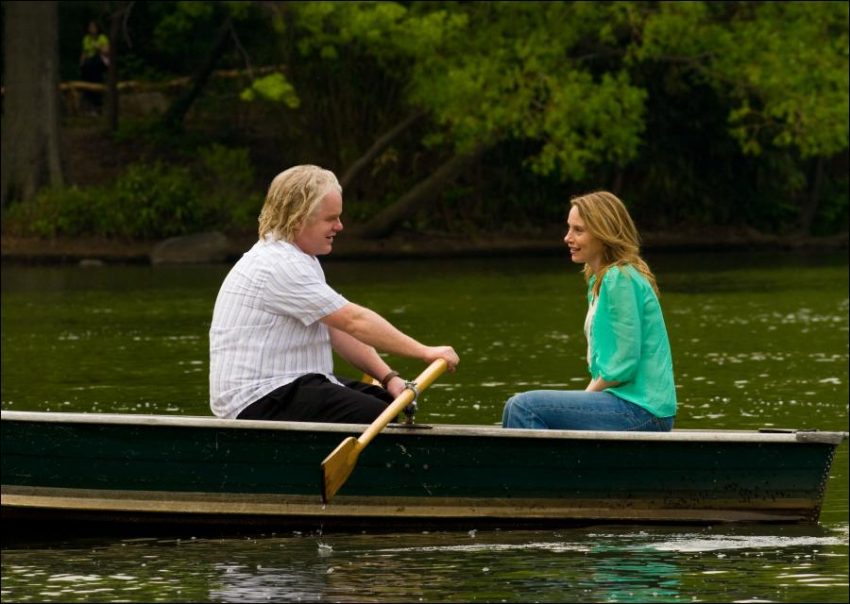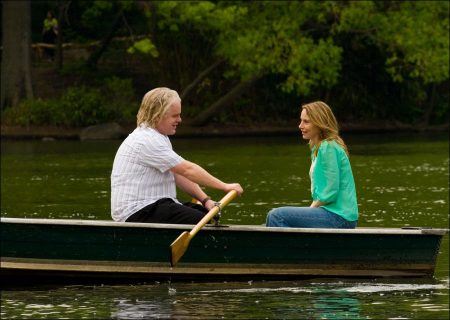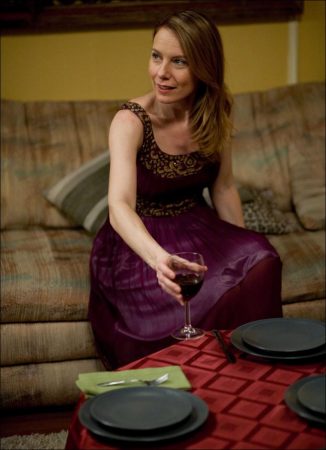Taglines: In love you either sink or swim.
“Jack Goes Boating” is an unconventional romantic comedy set in the midst of working-class New York City life. Based on the acclaimed Off-Broadway play of the same name, “Jack Goes Boating” stars John Ortiz (“Pride and Glory”), Daphne Rubin-Vega (Broadway’s “Rent”), Amy Ryan (“Gone Baby Gone”) and Philip Seymour Hoffman (“Capote”); with Hoffman making his feature directorial debut on the film. Bob Glaudini adapted his own play for the screen.
In the dead of winter, we meet Jack (Hoffman), a limo driver who has vague dreams of landing a job with the MTA, a mild obsession with a reggae song, and has begun a half-hearted attempt at growing dreadlocks. He spends most of his time hanging out with his best friend and fellow driver, Clyde (Ortiz) and Clyde’s wife Lucy (Rubin-Vega).
The couple set Jack up with Connie (Amy Ryan), a co-worker of Lucy’s at Dr. Bob’s Funeral Home in Brooklyn. Being with Connie inspires Jack to learn to cook, pursue a new career, and take swimming lessons from Clyde so he can give Connie the romantic boat ride she wants. But as Jack and Connie cautiously circle commitment, Clyde and Lucy’s marriage begins to disintegrate. From there, we watch as each couple must come face to face with the inevitable path of their relationship.
Jack Goes Boating began its life as a play produced by LAByrinth Theater Company. The creative home of former co-artistic directors Philip Seymour Hoffman and John Ortiz, the group includes some of New York’s most respected theater artists. Written by LAByrinth company member Bob Glaudini and directed by Peter DuBois (current artistic director of the Huntington Theatre Company), the play started with a critically and commercially acclaimed Off Broadway production starring Hoffman, Ortiz, Rubin-Vega and Beth Cole.
Glaudini says the idea for the story originated in what he calls a personal catastrophe. “At first, it was about a relationship between two of the characters that was one of the most hateful, ugly, awful things I could imagine,” he says. “Fortunately, as I wrote, the characters wouldn’t let me do that. But one of the themes that has remained throughout is that even if you are able to forgive a betrayal, you may still not be able to reconcile it.”
The playwright asked his colleagues at LAByrinth to take a look at his script. “I remember thinking it must be special because he had this sparkle in his eye,” says John Ortiz. “We workshopped it at the Summer Intensive, a retreat the company does every year. Everybody flipped over it and we decided to mount it as a production. All the stars were aligned in a perfect way.”
Even before the production opened, producer Beth O’Neil saw the play’s potential to become a feature film. “I read it in 2005 just after I produced another play by Bob Glaudini called ‘The Claiming Race,’” she remembers. “When he told me he had a new play, of course I wanted to read it. It was amazing. I would describe it as an unconventional romantic comedy about ordinary working-class New Yorkers, people we don’t usually get to see in films or plays. The characters were so vibrant.”
O’Neil urged Glaudini to adapt his work for the screen and took an early draft of the play’s script to Peter Saraf of Big Beach Films, believing that its quirky sensibility and emotional resonance would appeal to the producer of Little Miss Sunshine and Away We Go.
After reading the first draft of Bob’s screenplay, Saraf had the opportunity to see LAByrinth’s production of the play and this further ignited Saraf’s interest in the project. “Big Beach likes to make movies that get to the heart of the human experience,” says Saraf. “We like movies that are entertaining, but that are really about the ways in which people connect.”
Producer Marc Turtletaub adds, “Jack Goes Boating is an unusual love story in that it’s about three couples: a marriage that is reaching its end, a new romance that is blossoming and also the friendship between the two male characters in the film, Clyde and Jack, and what it means to them. The writing was already incredibly cinematic and it was easy to see how it could be opened up.”
O’Neil, Ortiz, Glaudini, Hoffman and Hoffman’s business partner Emily Ziff met with Saraf and his partners, and Bob and Phil agreed to begin the hard work of creating a film from the play, with Hoffman signing on to direct his first feature film. Involving LAByrinth in the workshopping of the screenplay was a natural and productive step in the development process. O’Neil recalls, “They workshopped the screenplay two years in a row at LAB’s Summer Intensive in Vermont.”
For Glaudini, returning to the script provided a new kind of satisfaction. “I got to revisit the work,” he says. “The experience of the play was overwhelmingly positive, but re-imagining it as a film gave me an opportunity to sharpen and focus it even more.”
Working with notes from the producers, Glaudini reshaped the original material into his first screenplay. “I was fortunate enough to work alongside Phil while I was doing it,” he says. “As the director, he processed the notes in ways that worked for him, and we continued the draft based on that. I don’t think writers often have the opportunity to shape the scenario with the person who is forming the artistic vision for the film. It was a kind of a rare collaboration.”
“Bob is an incredibly adept and collaborative writer who is very good at thinking in different mediums,” says Saraf.
“It was a natural choice to have Bob write the screenplay,” agrees Ziff. “Who better to see this through? The characters and story began with him, and he knows it all better than anyone. I can’t imagine how anybody else could have realized it so fully as a film.”
Jack Goes Boating is Philip Seymour Hoffman’s first foray into feature film directing, but he is an accomplished stage director and brought those skills to the project. “Phil did something I’ve never experienced on a film,” says Saraf. “He had a very long rehearsal process, not just with the actors, but with the director of photography, the script supervisor and the first assistant director. They not only worked on the performances and the script before they got to set, they also worked on the blocking and where the camera would be. The core team arrived incredibly well prepared and aware of what the task ahead would be.”
Hoffman had been interested in directing a film for some time, but taking on the dual roles of actor and director proved daunting. “As a director, I had to be available to the other people,” he says. “As an actor, it’s a small movie with four main characters. In a lot of scenes, there are just two actors, so you’re half the acting. That was tricky. No one should be thinking about themselves that much through any given day. It’s just not healthy.”
Fortunately, says Hoffman, he had plenty of help from his co-creators. “Our producers Peter Saraf and George Paaswell were on the set to provide support the whole way,” he says. “Bob Glaudini was there every day to support us and to be a watchful eye if we needed to do any changes in the writing. I wanted him to be aware of what had to happen and make sure he was part of it. Everyone on the film was personally involved, which made shooting it really satisfying. It wasn’t just another job.”
Saraf adds: “Bob and Phil have a working relationship already from LAByrinth, so they have a kind of shorthand. It was fascinating to see what a collaborative process it was.
“Working with Phil has been an incredible experience overall,” continues the producer. “It was a joy to watch him take the unparalleled instincts he has honed as an actor and translate that into directing. It’s not an easy feat, but Phil is a natural filmmaker, passionate and practical at the same time. And he’s incredibly well prepared.”
“Jack Goes Boating is funny, but the humor comes from real situations, not jokes,” adds Turtletaub. “It’s about real people, all of them very sympathetic in their own way, who are struggling with what it means to be in love, what it means to be committed to a relationship. Audiences can expect to come to the movie theater and see incredible acting by a cast that could not be more perfect in a story that will make them laugh.
“And it will give them the opportunity to incorporate their own story into what they’re seeing on the screen,” says Saraf. “I think that the best thing we can hope for when we go to the movies is to be able to identify with what we’re seeing up there and take something of it away with us.”
Jack Goes Boating (2010)
Directed by: Philip Seymour Hoffman
Starring: Philip Seymour Hoffman, Amy Ryan, John Ortiz, Lola Glaudini, Elizabeth Rodriguez, Daphne Rubin-Vega, Stephen Adly Guirgis, Theodore Mailer, Elizabeth Rainer, Mason Pettit
Screenplay by: Bob Glaudini
Production Design by: Thérèse DePrez
Cinematography by: W. Mott Hupfel
Film Editing by: Brian A. Kates
Costume Design by: Mimi O’Donnell
Set Decoration by: Rebecca Meis DeMarco
Art Direction by: Matteo De Cosmo
Music by: Grizzly Bear, Evan Lurie
MPAA Rating: R for language, drug use and some sexual content.
Distributed by: Overture Films
Release Date: September 17, 2010





